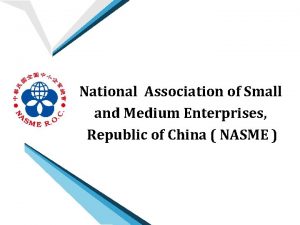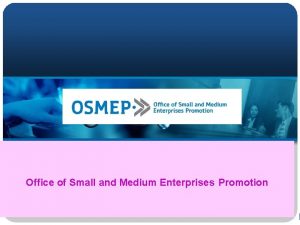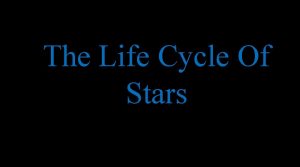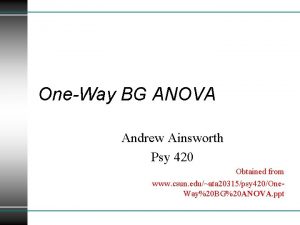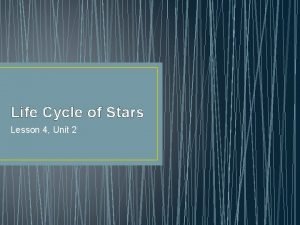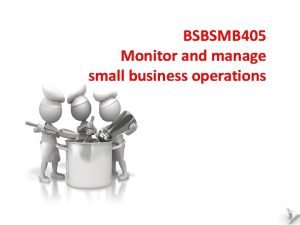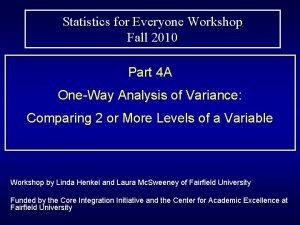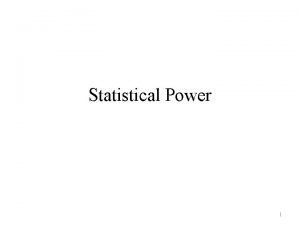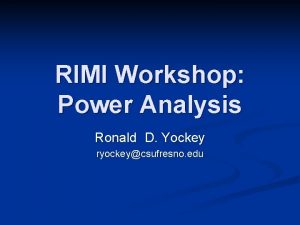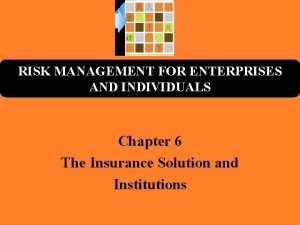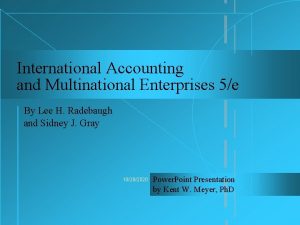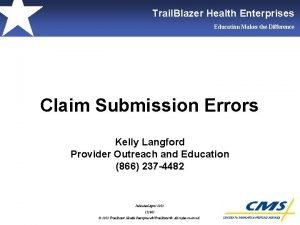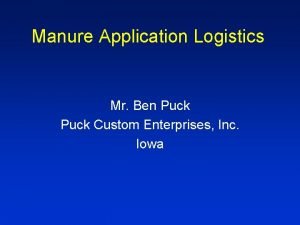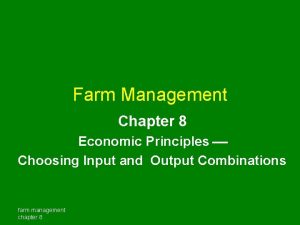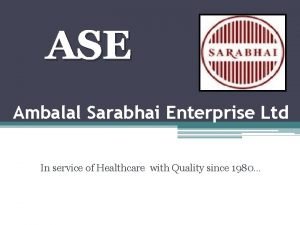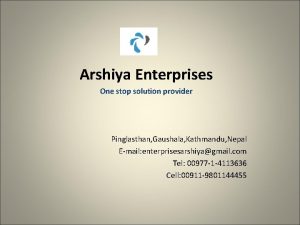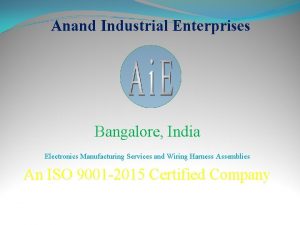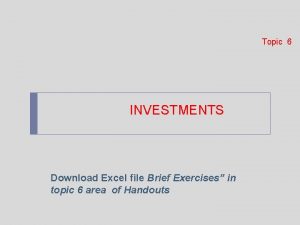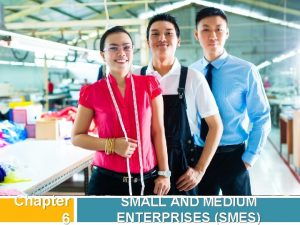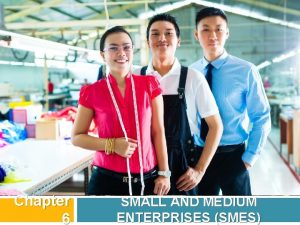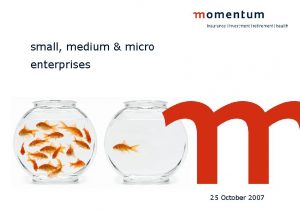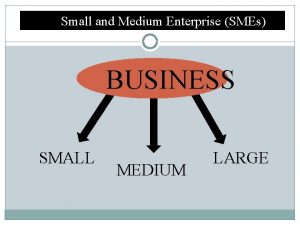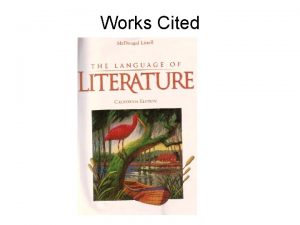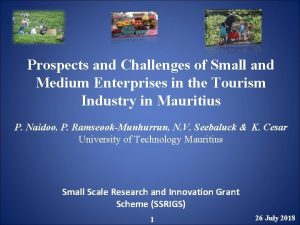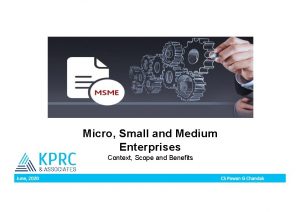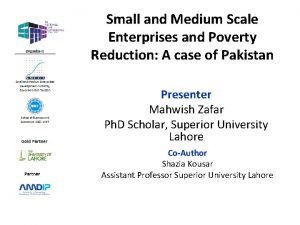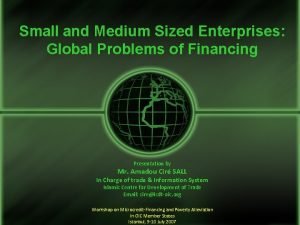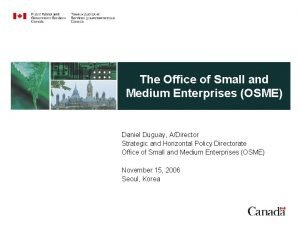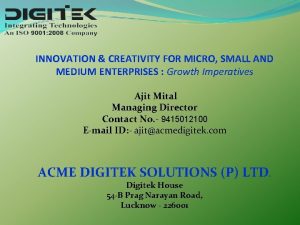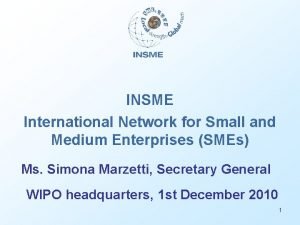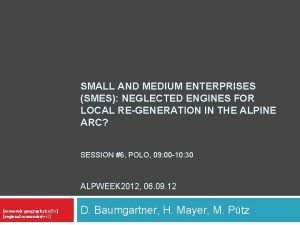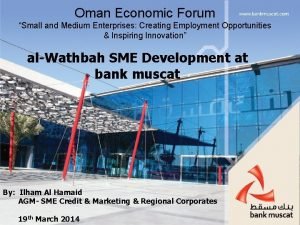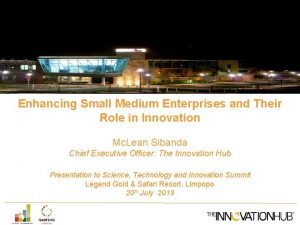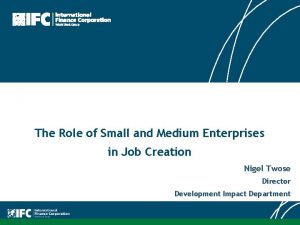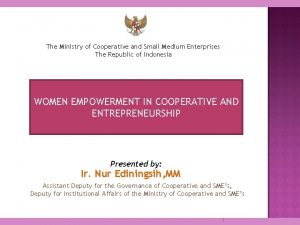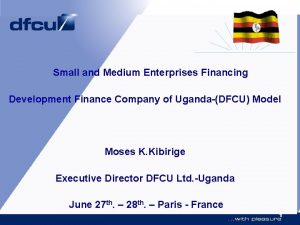Growing Small and Medium Enterprises What Works Speaker
























- Slides: 24

Growing Small and Medium Enterprises: What Works? Speaker: Ron Ashkin, USAID Link. SME / IESC Facilitator: Anastasia de Santos, USAID Trade & Regulatory Reform Office MAY 14, 2019

USAID LINKAGES FOR SMALL AND MEDIUM ENTERPRISES (Link. SME) Understanding the Logic behind Link. SME Ron Ashkin, IESC Project Director rashkin@linksme. org Image: East-West Industries

THE LINKSME CONTRACT C. 2 PURPOSE C. 4 OBJECTIVES • Systemic changes in business relationships between Vietnamese Small and Medium-sized Enterprises (SMEs) and foreign firms. • At the end of the contract, the contractor must achieve these two objectives: • Significant increases in the quantity and/or quality of business linkages between Vietnamese SME-firms and foreign firms…USAID assumes that by linking SMEs to foreign firms, the SMEs will become part of the global value chain (GVC). 1. Strengthen the SME-foreign firm business linkage framework 2. Enhance Vietnamese SMEs’ capacity to participate in the GVC in 5 sectors

THEORIES OF CHANGE: HIGH-GROWTH SME DEVELOPMENT What works? INTERVENTION CATEGORY BUSINESS DEVELOPMENT SERVICES ACCESS TO FINANCE BUSINESS ENABLING ENVIRONMENT MARKET ACCESS INNOVATION USAID Link. SME INTERVENTION TYPE LEVEL OF EVIDENCE LEVEL OF IMPACT TRAINING STRONG LOW CONSULTING SERVICES STRONG HIGH MATCHING GRANTS WEAK MIXED-HIGH ACCESS TO CREDIT MODERATE HIGH FIRM REGISTRATION WEAK LOW TAX POLICIES AND ADMINISTRATION MODERATE HIGH MARKET LINKAGES MODERATE HIGH EXPORT PROMOTION AND SUPPORT WEAK MIXED SUPPORT FOR PRODUCT INNOVATION WEAK MIXED

USAID Link. SME VIETNAM We Only Do Two Things ü Economic value created for SMEs and VN economy ü Multiplier effect from more local content 2. Consulting Services (Technical Upgrades) 1. Market Linkages (Matchmaking) ü Lessons learned for replication and scale ü Lessons learned to inform GVN policy

UNDERSTANDING OUR JOB What is Link. SME? • We are a supply chain consulting firm • Our mission is to deepen Vietnamese local content foreign firms (FFs) that serve the global marketplace • We do this by facilitating linkages between Vietnamese SMEs and FFs (Michael Porter: Value is created at the enterprise level) • Our success is measured by the linkages we help create • Linkage defined not only as matchmaking, but also spans technical assistance for supplier development, manufacturing, delivery, acceptance, and payment (long cycle) • Our services to SMEs are not free, they are quite expensive • In return, we always want data • We are paid by a third party, USAID • We consider Value for Money (Vf. M) = effectiveness, efficiency, economy

THINK LIKE A BUSINESS • We are a private sector organization, implementing a private sector development program • Like a business, quantitative targets define our success • We also have to spend our budget effectively (get value for money for our investors) • Some fundamental management principles: • Customer focus • Process approach • Continuous improvement (USAID says “CLA” = collaborating, learning, adapting, part of our contract) • Understand private sector incentives

THEORY OF CHANGE aka INTERVENTION LOGIC Definitions Implications • The terms ‘Theory of Change’, ‘Intervention Logic’, and ‘Development Hypothesis’ are interchangeable (my preference: ‘Intervention Logic’) • All of our activities (e. g. events, partnerships, consulting, training) should lead to more SME-Foreign Firm linkages • Should be clear, simple and understandable to all stakeholders, not just the M&E specialists • Should explain WHY we are doing program activities, and link activities to ultimate economic impact • There must be a strong causal relationship between our activities (inputs) and the intended purpose (impact) of the project, which is to create more and better linkages • If they don’t – don’t do them • The logic behind this can be mapped with a ‘results chain’ • The results chain then generates a measurement plan by which we gather evidence • Evidence serves both to measure success and to inform adaptations in approach so we can be more effective (CLA)


WE HAVE ALL SEEN THIS BEFORE Impact 1, 000 jobs were created HOW? Miracle happens Input Our project trained 50 people © 2017 Ronald E. Ashkin All Rights Reserved

INTERVENTION LOGIC TAKES FOUR BASIC STEPS Market activity USAID Link. SME facilitation Impact Because of these changes, quantity and quality of SME-FF linkages increase Outcome Changes in business behavior appear in the marketplace based on this new capacity Output Input Partners gain capacity because of Link. SME assistance Link. SME delivers technical assistance to partners that addresses systemic market issues at root cause level The starting point - accurate problem definition

RESULTS MEASUREMENT AT USAID LINKSME Guiding Principles • You can’t manage what you don’t measure • If you don’t document it, it didn’t happen • Zen proverb: “If a tree falls in the forest and nobody hears it, did it make a sound? ” • Embed measurements into daily work • Minimize after-the-fact measurements and surveys • Check progress at each step of the process – don’t wait until the car is fully built to see if it has any defects • Measure what is essential to verify and evidence logic – no more and no less • Use existing business indicators – don’t invent new ones • Measurement is a mandatory partner obligation, in every MOU • Monitoring and evaluation are integrated into the intervention process – not a separate ‘policeman’ function

EXPRESSING AND VERIFYING LOGIC Methodology Some Subtleties • Each intervention has its own results chain expressing its intervention logic and measurement plan, showing how it will be measured • Attribution • There must be cause-and-effect • Can results be logically ascribed to our project’s assistance? • Additionality • We actually catalyze a change that would not have happened without our assistance • The partner would not have done it anyway without us (i. e. , we are not just paying the partner’s bills) • Other donors are not doing the same thing • For example, events all have M&E requirements defined in the concept note • There is an independent global methodology for measurement in private sector development – the DCED standard www. enterprise-development. org/

THE RESULTS CHAIN “CHEAT SHEET” What the Results Chain Says Impact Outcome Output Inputs (project activities) What It Means What is the end result for our target group? What is the Logic For This Intervention? How Will We Measure It? What changes happen in the marketplace that can be attributed to our assistance? What capacity has the partner gained? What is the partner able to do because of our intervention that couldn’t be done before? What does the project do for the partner?

THE RESULTS CHAIN “CHEAT SHEET” EXAMPLE What the Results Chain Says Impact Outcome Output Inputs (project activities) What It Means What is the Logic For This Intervention? How Will We Measure It? SMEs supply product Count number and to FFs value of orders produced, delivered, and paid SMEs link to FFs, Count number of What changes happen in understand SMEs considered the marketplace that can be requirements, for FF RFQs attributed to our upgrade, and become potential suppliers assistance? What is the end result for our target group? Attending SMEs What capacity has the understand the partner gained? What is the benefits of Link. SME partner able to do because and how to participate in the of our intervention that couldn’t be done before? project What does the project do Support VCCI to hold SME supply chain for the partner? Track number of SMEs registered into the Link. SME online database Keep track of number of SMEs

PROJECT EXPENDITURE To ensure sustainability, USAID Link. SME should not become a market player. We will invest in development activities (one-time, catalytic) while avoiding paying for transactions or assets. Development Transactional • Capacity building • Capital investment • Technical advisory • Construction • Matchmaking • Staff costs • Connections and referrals • Equipment • Piloting and demonstration • Input supplies • Market intelligence • Sitting fees and per diems

PROJECT EXPENDITURE Food for thought • Are we just paying the partner’s bills for them? • Would they have done it anyway? • Is our intervention building capacity to do it on their own in the future? How? • Does our intervention expenditure contribute to systemic change, or does it just solve business problems for the partner? • Did we conduct a thorough problem definition and root cause analysis to assure that we are addressing priority issues, or did we just accept the partner’s request? Image: National Gallery of Art • If we step away, is the partner on the road to impact?

VALUE FOR MONEY (VFM) Practical Experience High Vf. M • • Local LTTA Trade exhibitions Matchmaking Targeted partner events Moderate Vf. M • Local STTA Low Vf. M • Expat STTA (long assignments) • Expensive venues • Untargeted events • Partner wish lists • Value for Money can be monetized and calculated as Input ÷ Impact • USAID Link. SME illustration: • For an event intended to recruit SMEs into our database • Money spent ÷ # of online registrations = cost per registration • Can be compared between partners and channels to determine most effective

BUILDING SUSTAINABILITY Partner vs. Vendor Partner Vendor • Shares mutual objective(s) with the project • Objective is purely economic (an exchange of value, i. e. , product or services for money) • At minimum, must coincide with one of the project’s top-line development objectives • USAID Link. SME: creating global value chain linkages, changing the system • Contributes resources to the partnership • Mutual activities are cost-shared based on each partner’s responsibilities • USAID Link. SME starts with 50/50 cost share • Builds sustainability through self-reliance • Transaction orientation • No cost share, expects 100% payment by the project • Project role is ultimately just to pay the bill • No sustainability, must pay again next time

THOUGHTS ON IMPACT Evidence Coming Down to Earth • Impact must be evidenced, not just illustrated • An intervention may create impact, but is that impact sustainable? It is always possible to buy impact (= old school development, absent theory of change) • Success stories are illustrations, not results measurement • Methodology matters • Is the impact scalable and system-wide, or does it just affect a pilot group and will magically scale up sometime after the project is over? • Is Value for Money considered, or did we spend $1 million to create $100, 000 in impact?

1 What might be applied to other programs and contexts? What are the indispensable lessons to share with others? Do What Works! Not what you think might work. Base your interventions on sound evidence. If it didn’t work repeatedly in the past, it is unlikely to work in the future. 2 Sound Logic is Key 3 Anecdote to Evidence 4 Think Like a Business 5 Think Sustainability 6 Avoid Pilotitis Your intervention logic should be obvious to a third-party observer and not a “stretch” that has to be explained in detail to non-specialists. Avoid a leap of faith from outcome to impact. Distinguish vendors from partners. Sustainability comes from transferring capacity to local partners and they must have a stake in the game. Simply paying for impact leads to no sustainability. Success stories are a communication tool, anecdotal illustrations of development impact. But they are neither a substitute for nor a proxy for robust evidence-based M&E. Anyone can do a pilot, but a one -off impact is not evidence of systemic change. Work for scale; the development challenge is not to prove that a concept is possible, but to make the concept take hold systemwide. SME development programs have different characteristics than other types of programming. Leveraging private sector investment requires understanding of private sector incentives. 7 Firms Create Value The business environment doesn’t create value, enterprises create value. You can’t expect to improve SME performance unless you engage directly with SMEs.

QUESTIONS?

VIETNAMFLAVOR. COM http: //bit. ly/Link. SME 1 USAID Linkages for Small and Medium Enterprises Contact Information: USAID/Vietnam: Thuy Nguyen, Contracting Officer’s Representative (COR) thuynguyen@usaid. gov Michael Trueblood, Director, Office of Economic Growth and Governance mtrueblood@usaid. gov USAID Link. SME: Ron Ashkin, Project Director rashkin@linksme. org Lien Duong, Deputy Project Director/SME Linkages Component Director duonglien@linksme. org Frank Weiand, Foreign Firm Linkages Component Director fweiand@linksme. org Slide No. 23

Contact: koplanick@usaid. gov Comment on today’s topic: https: //www. marketlinks. org/event/growing-small-and-mediumenterprises-what-works Tweet tips! twitter. com/marketlinksorg Post resources! facebook. com/marketlinksorg
 National association of small and medium enterprises
National association of small and medium enterprises Bulgarian small and medium enterprises promotion agency
Bulgarian small and medium enterprises promotion agency Office of small and medium enterprises promotion
Office of small and medium enterprises promotion Objectives of micro and macro enterprises
Objectives of micro and macro enterprises Hot media and cool media
Hot media and cool media Work improvement in small enterprises
Work improvement in small enterprises Vydj
Vydj Street works risk assessment
Street works risk assessment Life cycle of a low medium mass star
Life cycle of a low medium mass star Small effect size
Small effect size Star with small and medium mass
Star with small and medium mass Small business operations
Small business operations Effect size f small, medium large
Effect size f small, medium large Cohen's d
Cohen's d Effect size f small, medium large
Effect size f small, medium large Risk management for enterprises and individuals
Risk management for enterprises and individuals International accounting and multinational enterprises
International accounting and multinational enterprises Trailblazer health enterprises
Trailblazer health enterprises Puck manure
Puck manure Input substitution ratio
Input substitution ratio How many types of business
How many types of business Ambalal sarabhai
Ambalal sarabhai Arshiya enterprises
Arshiya enterprises Electronic manufacturing services
Electronic manufacturing services Lance brothers enterprises acquired
Lance brothers enterprises acquired
